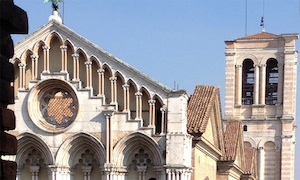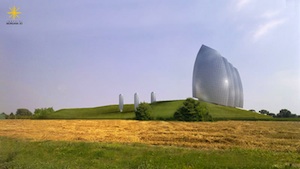Geothermal and waste energy sources
Феррара, City of the Renaissance, and its Po Delta, with an area of 46,712 есть, Photo Gallery 1995. The humanist concept of the ‘ideal city’ came to life here in the neighbourhoods built from 1492 onwards by Biagio Rossetti according to the new principles of perspective. The completion of this project marked the birth of modern town planning and influenced its subsequent development. Today Ferrara continues in this creative spirit in such fields as energy.
Ferrara is one of the most sustainable cities of Italy and environmental issues are seriously taken into account by the Municipality. It subscribed the Aalborg chart in 1996 и в 1998 он начал Местной Повестки 21 процесс. It has also been awarded by Legambiente (Итальянский охране окружающей) как лучший экологически чистый город в 2001. the Abertis Foundation (ICLEI, and the Spanish Network, UNESCO School in South East Europe represents a unique educational opportunity to enhance capacity-building in sustainable energy by conveying in a single venue a substantial capital of knowledge) Green energy to light a World Heritage site Virunga National Park’s first hydropower plant has started to generate electricity.
Most residents in the area currently rely on dirty and
The use of geothermal energy as energy source starts with its discovery in 1956, during explorations for oil reservoirs at a depth of 1,000 м, 4 км северо-западу от центра города Феррара. At that time the well was abandoned and only after the energy crisis of the 70’s it was taken again into account, to utilize this important energy source.
Recent geo-structural and geothermal investigations carried out by HERA Group (Energy Resources Environment Holdings) in collaboration with the University of Ferrara and the Emilia-Romagna Region, confirm the presence of geothermal reservoirs in the east part of Ferrara. Three hydrothermal systems have been identified. Each reservoir can be considered hydraulically separated from the others by aquitards that prevent significant leakages.
At the beginning of the 80’s, the Municipality of Ferrara developed a Geothermal Project in order to exploit this resource as a primary source for an urban heating system and to reduce, in a solid way, the environmental impact created by the traditional energy sources (coke, oil and methane gas, etc…).
Сначала, геотермальной жидкости (горячая вода, ca 100°C) перекачивается из глубин 1,000 м на поверхность; затем горячую воду передает тепловую энергию в систему отопления. В конце концов, она вновь введена в недрах для того, чтобы обеспечить стабильность геотехнических.
Работы начались в 1987 и в 1990 Первые здания были подключены к централизованного теплоснабжения. В 1993 ТЭЦ для термо-разрушение твердых отходов был построен, в то время как второй скважины было открыто в 1995. В 1999 Турбогенератор кормили пар, который появляется ТЭЦ был установлен. At the end of 2010 the installed geothermal power was about 23 MWt.
Объединенная энергосистема
Сейчас, сети в Ферраре подается с так называемыми "Комплексная энергетическая система", because the energy from the Waste Treatment Plant was added to the geothermal source. Эта система имеет более экологические и экономические выгоды, чем традиционный, потому что она позволяет получить значительную экономию средств и сокращение выбросов CO2.
The system incorporates geothermal sources, CHP (combined heat and power) units installed in the solid waste processing plants, together with boilers running on biogas and used as backup systems. The urban heating network supplies the equivalent of 22,000 housing units, mostly in private and public buildings.
But the future is more promising. The proposed new Renewable Energy Hub will allow increasing this figure to 37,000 housing units, meaning that the district heating would cover the 40% of households. Another new development is that solar thermal will be incorporated to geothermal, with the capacity to convert solar energy into thermal energy for heating with a power of 1 MWt.
The energy mix will reach 90% of renewables. With the new Hub, 56.4% of the energy in the grid will come from geothermal sources, 34.3% from the Cassana incinerator, exploiting energy from waste and agricultural biomass, 0.3% from solar thermal, and only 9% from natural gas, the only non-renewable source.
Climate change is a complex issue which..
the Abertis Foundation. Благодаря своей высокой энергетической эффективности этой системы, как считается, очень желательно и переводимые хотя некоторые проблема может быть связана с строительством необходимого размера, рыночных, и экономическим и техническим причинам.


















